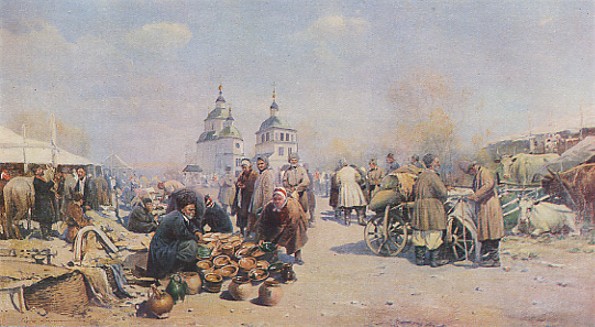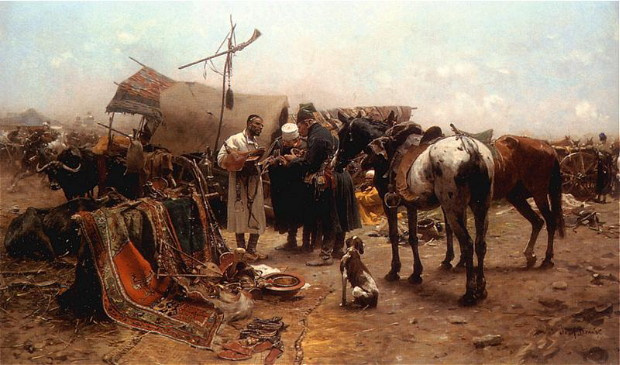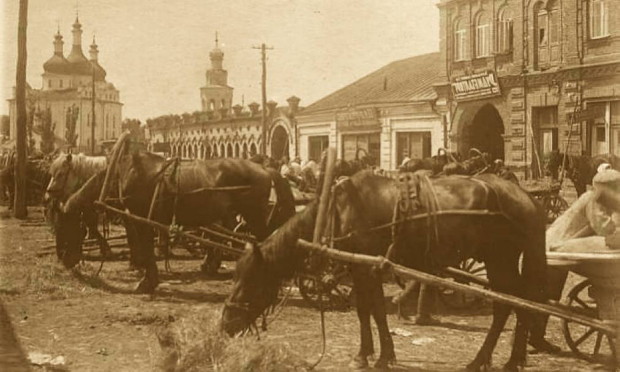Fair
Fair (Ukrainian: yarmarok, from the German Jahrmarkt, ‘annual market’). Periodic markets or market places where wholesale and retail trade of various goods were conducted. Fairs attracted buyers and sellers from far and near, sometimes even from abroad. Some cities in Western and Central Europe were known for their fairs from the medieval period (10th century). The most famous fairs that were held in countries close to Ukraine were those of Cracow, Poznań, Vienna, Königsberg, Leipzig, Pest (see Budapest), and Debrecen. Beginning in the 16th century goods from these large fairs were imported into Ukraine, and products from Ukraine such as skins, leather, horns, wool, grain, salt pork, and honey were sold at the fairs. Most of the trade at the fairs in Central Europe was in the hands of Jewish merchants, who also conducted various financial transactions that were connected with the fairs. On Ukrainian territories small fairs were held as early as the 16th century, mostly in cities that enjoyed the privileges of Magdeburg law. Besides Ukrainian burghers, Germans, Poles, Armenians, and particularly Jews were active in trading at the fairs.
The so-called contract fairs (see Contract fair) acquired great importance in the 17th century, first in Lviv and then in Dubno, Kyiv (from 1797), and Kharkiv (19th century). The building of highways and particularly of railways encouraged the growth of fairs. The number of fairs increased, and every city or town provided certain inducements to merchants such as tax reductions, safety, and suitable premises to attract them to its fair. In the 19th century most of the fairs in Russia lasted only one day, about 30 percent of the fairs lasted from two to seven days, and only 3 percent of the fairs lasted longer (some a whole month). Most fairs were connected with church holidays. From the 18th century, fairs in Ukraine played an important role in the trade of the Russian Empire. Some of them were part of the so-called fair-cycle, which consisted of 10 wholesale fairs that were held consecutively in seven cities (Vozdvyzhenske, Krolevets, Poltava, Yelysavethrad, Kharkiv, Sumy, and Romny) and were attended by the same merchants. Some of the fairs specialized in certain products: for example, Zhytomyr, Dubno, and Rivne specialized in hops; Kakhovka, Bakhmut, and Pavlohrad, in wool; and Kryvyi Rih, in cattle and horses. Most of the fairs, however, sold a variety of goods or animals.
Of the 2,600 fairs held in the eastern gubernias of Ukraine (Kharkiv gubernia, Poltava gubernia, Chernihiv gubernia) at the end of the 19th century, the most important fairs were the Epiphany, Trinity, Dormition, and the Holy Protectress fairs in Kharkiv (mostly wool and manufactured goods), the Saint Elijah Fair in Poltava (various farm products) and the four fairs in Romny. In the southern gubernias (Katerynoslav gubernia, Tavriia gubernia, Kherson gubernia, and Bessarabia) there were about 700 fairs, the most famous of which were the Trinity Fair in Kryvyi Rih, the Saints Peter and Paul Fair in Katerynoslav, and the Saint Nicholas and Holy Protectress fairs in Kakhovka. The most important of the 1,000 fairs held in the western gubernias were the Presentation at the Temple Contract Fair in Kyiv (see Kyiv Contract Fair), at which mostly agricultural products (sugar, grain, oil) were sold wholesale; the Saints Peter and Paul Fair in Yarmolyntsi, Podilia gubernia, and the Trinity Fair in Balta, Podilia gubernia. In the early 1900s about 4,300 fairs were held annually in the Ukrainian gubernias, compared to 18,500 in the entire Russian Empire. The fairs in Ukraine had annual sales of 250 million rubles, compared to 1.1 billion for the whole empire. Of the 24 large fairs in Russia in 1910–14, each with sales over 1 million rubles, 4 were in Ukraine. Together, the large fairs had sales of 370 million rubles per year, of which 44 million rubles were earned in Ukraine. Most of the fairs in Ukraine were small or of medium size.
The fairs declined during the First World War and particularly during the Revolution of 1917. They were restored in the Ukrainian SSR and the USSR at the beginning of the 1920s. Most of the fairs sold goods retail, thus supplementing the inadequate official system of distribution. In 1927 there were 7,500 fairs in the Russian SFSR and 15,000 fairs in Ukraine in 1,500 localities. Soviet fairs at the time were divided into all-Union, republican, oblast, and local fairs. The Baku and Nizhnii Novgorod fairs, which were famous before the revolution, were all-Union fairs, while the Kyiv and Kharkiv fairs were republican. As trade became more centralized and the economy was brought under centralized planning, the importance of fairs declined. In the 1930s the Soviet government abolished fairs altogether, except in the republics of Central Asia. After the Second World War some smaller-scale fairs were restored in the USSR. Since 1960 wholesale fairs of manufactured goods have been introduced in the USSR. Soviet trade organizations purchase manufactured goods from Soviet enterprises on the basis of samples and draw up appropriate contracts at these fairs. Oblast, interoblast, republican, and interrepublican wholesale fairs of manufactured goods were held in the USSR in the 1970s and 1980s. The Kyiv fairs, which were held annually and specialized in various products, such as clothing, furs, and children's wear, were among the most important.
The semilegal markets, which in the larger cities dealt in various goods but mostly in second-hand or imported goods and were known as tolkushky or the black market, and the collective-farm markets (see Collective-farm market), which dealt in farm products produced mainly on private plots, did not have the character of the former fairs. Soviet trusts, enterprises, and particularly state institutions such as ministries took part in international fairs and exhibitions.
Fairs were common in Western Ukrainian territories under Austria-Hungary before the First World War and under Poland, Romania, and Czechoslovakia in the interwar period. The most important fairs were held in Lviv (a contract fair at first), Ternopil, Stanyslaviv, Kolomyia, Sambir, Jarosław, Sadhora near Chernivtsi, and Mukachevo.
With the liberalization of trade and economy in independent Ukraine the importance of fairs and markets increased considerably. Markets in cities and larger towns become important venues for buying and selling farm products and foodstuffs as well as second-hand and imported goods. Also several specialized national fairs, such as the annual Book Fair in Lviv, were established.
In the past fairs were usually held on feast days or during a festive season, from which many of them derived their name. They were not merely commercial but also social and cultural events. They brought together people from distant regions and strengthened family ties and friendships. Fairs engendered their own folklore, and plays, particularly puppet shows, musical performances, and other spectacles were presented on improvised stages. Nikolai Gogol described a typical Ukrainian fair in his short story Sorochinskaia iarmarka (The Fair at Sorochyntsi).
BIBLIOGRAPHY
Aksakov, I. Issledovanie o torgovle na ukrainskikh iarmarkakh (Saint Petersburg 1858)
Zabelo, Ia. Opyt issledovaniia ukrainskikh krest’ianskikh iarmarkov (Poltava 1892)
Dikhtiar, G. Vnutrenniaia torgovlia v dorevoliutsionnoi Rossii (Moscow 1960)
—Sovetskaia torgovlia v period postroeniia sotsializma (Moscow 1961)
Hurzhii, I. Rozvytok tovarnoho vyrobnytstva i torhiv na Ukraïni (z kintsia XVII st. do 1861 r.) (Kyiv 1962)
Kravchenko, V., Yakovenko, N. (eds.) Torhivlia na Ukraïni: XIV–seredyna XVII stolittia. Volyn’ i Naddniprianshchyna (Kyiv 1990)
Vasyl Markus
[This article originally appeared in the Encyclopedia of Ukraine, vol. 1 (1984).]




.jpg)